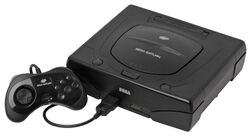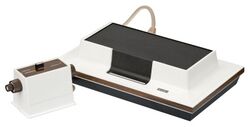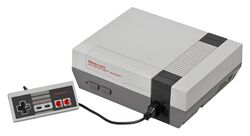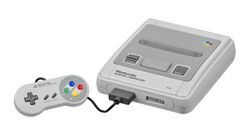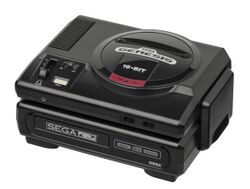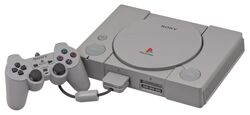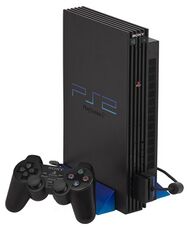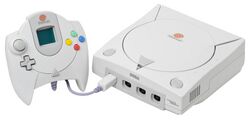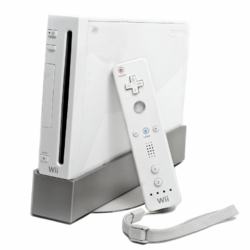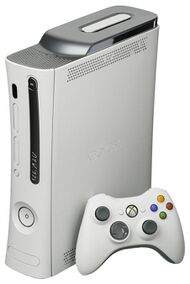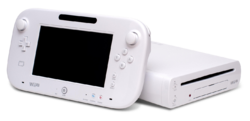Home video game console generations
Topic: Engineering
 From HandWiki - Reading time: 40 min
From HandWiki - Reading time: 40 min
| It has been suggested that this page be merged into History of video game consoles. (Discuss) Proposed since November 2023. |
In the video game industry, the market for home video game consoles has frequently been segmented into generations, grouping consoles that are considered to have shared in a competitive marketspace. Since the first home consoles in 1972, there have been nine defined home console generations.
A new console generation typically has occurred approximately every five years, in keeping pace with Moore's law for technology, though more recent generations have had extended periods due to the use of console revisions rather than completely new designs. Not all home consoles are defined as part of these generations; only those considered to be significant competitive consoles are classed into generations, and systems such as microconsoles are often omitted from these generations.
Background and origins
Like most consumer electronics, home video game consoles are developed based on improving the features offered by an earlier product with advances made by newer technology. For video game consoles, these improvements typically occur every five years, following a Moore's law progression where a rough aggregate measure of processing power doubles every 18 months or increases ten-fold after five years.[1][2][3] This cyclic market has resulted in an industry-wide adoption of the razorblade model in selling consoles at minimal profit margin while making revenue from the sale of games produced for that console, and then transitioning users to the next console model at the fifth year as the successor console enters the market. This approach incorporates planned obsolescence into the products to continue to bring consumers towards purchasing the newer models.[4]
Because of the industry dynamics, many console manufacturers release their new consoles in roughly the same time period, with their consoles typically offering similar processing power and capabilities as their competitors. This systematic market has created the nature of console generations, categorizing the primary consoles into these segmented time periods that represent consoles with similar capabilities and which shared the same competitive space. Like consoles, these generations typically start five years after its prior one, though may have long tails as popular consoles remain viable well beyond five years.[5][6]
The use of the generation label came after the start of the 21st century as console technology started to mature, with the terminology applied retroactively to earlier consoles. However, no exact definition and delineation of console generations was consistently developed in the industry or academic literature since that point. Some schemes have been based on direct market data (including a seminal work published in an IEEE journal in 2002),[7] while others are based on technology shifts. Wikipedia itself has been noted for creating its own version of console generation definitions that differ from other academic sources, the definitions from Wikipedia has been adopted by other sources but without having any true rationale behind it.[5] The discrepancies between how consoles are grouped into generations and how these generations are named have caused confusion when trying to compare shifts in the video game marketplace compared to other consumer markets.[5] Kemerer et al. (2017)[5] provide a comparative analysis of these different generations through systems released up to 2010 as shown below.
ImageSize = width:1000 height:auto barincrement:15 PlotArea = left:180 bottom:80 top:20 right:20 Alignbars = justify DateFormat = mm/dd/yyyy Period = from:01/01/1970 till:12/31/2014 TimeAxis = orientation:horizontal format:yyyy Legend = orientation:vertical position:bottom columns:4
Colors =
id:First value:blue legend:First id:Second value:red legend:Second id:Third value:green legend:Third id:Fourth value:purple legend:Fourth id:Fifth value:rgb(0.2,0.4,0.4) legend:Fifth id:Sixth value:orange legend:Sixth id:Seventh value:rgb(0,0.9,0.9) legend:Seventh id:mark1 value:rgb(0.7,0,0) id:grida value:gray(0.7) id:gridb value:gray(0.88)
ScaleMajor = gridcolor:grida unit:year increment:5 start:1970 ScaleMinor = gridcolor:gridb unit:year increment:1 start:1970
BarData =
bar:dummy0 barset:Consoles text:"Major console releases" bar:dummy1 bar:GP02 text:"Gallagher and Park (2002)" bar:HP06 text:"Prieger and Hu (2006)" bar:CL08 text:"Corts and Lederman (2008)" bar:G10 text:"Gretz (2010)" bar:G10a text:"Gretz (2010a)" bar:SV10 text:"Srinivasan and Venkatraman (2010)" bar:D11 text:"Derdenger (2011)" bar:Z11 text:"Zhou (2011)" bar:Wiki text:"Wikipedia" bar:dummy2
PlotData=
- Consoles
barset:Consoles width:10 shift:(5,-5) mark:(line,mark1) at:09/01/1972 text:"Magnavox Odyssey" at:07/01/1975 text:"Pong (home)" at:11/01/1976 text:"Fairchild Channel F" at:09/11/1977 text:"Atari 2600" at:12/03/1979 text:"Intellivision" barset:break at:08/01/1982 text:"ColecoVision" at:10/01/1982 text:"Atari 5200" at:07/15/1983 text:"NES" at:10/20/1985 text:"Master System" at:05/01/1986 text:"Atari 7800" barset:break at:10/30/1987 text:"TurboGrafx-16" at:10/29/1988 text:"Sega Genesis" at:11/21/1990 text:"SNES" barset:break at:10/04/1993 text:"3DO" at:11/23/1993 text:"Atari Jaguar" at:11/22/1994 text:"Sega Saturn" at:12/03/1994 text:"PlayStation" at:06/23/1996 text:"Nintendo 64" barset:break at:11/27/1998 text:"Dreamcast" at:03/04/2000 text:"PlayStation 2" at:07/14/2001 text:"GameCube" at:11/15/2001 text:"Xbox" barset:break at:11/22/2005 text:"Xbox 360" at:11/11/2006 text:"PlayStation 3" at:11/19/2006 text:"Wii"
width:11 textcolor:black align:left shift:(0,-0) mark:none bar:GP02 from:11/01/1976 till:12/31/1978 color:First bar:GP02 from:01/01/1979 till:12/31/1984 color:Second bar:GP02 from:01/01/1985 till:06/30/1988 color:Third bar:GP02 from:07/01/1988 till:06/30/1992 color:Fourth bar:GP02 from:07/01/1992 till:12/31/1999 color:Fifth bar:GP02 from:01/01/2000 till:12/31/2004 color:Sixth bar:HP06 from:01/01/1999 till:12/31/2002 color:Sixth bar:CL08 from:01/01/1985 till:12/31/1985 color:Third bar:CL08 from:01/01/1989 till:12/31/1991 color:Fourth bar:CL08 from:01/01/1992 till:12/31/1998 color:Fifth bar:CL08 from:01/01/1999 till:12/31/2004 color:Sixth bar:G10 from:01/01/1976 till:12/31/1984 color:First bar:G10 from:01/01/1985 till:12/31/1990 color:Second bar:G10 from:01/01/1991 till:12/31/1998 color:Third bar:G10 from:01/01/1999 till:12/31/2004 color:Fourth bar:G10a from:01/01/1976 till:12/31/1984 color:First bar:G10a from:01/01/1985 till:06/30/1988 color:Second bar:G10a from:07/01/1988 till:06/30/1992 color:Third bar:G10a from:07/01/1992 till:12/31/1998 color:Fourth bar:G10a from:01/01/1999 till:12/31/2004 color:Fifth bar:G10a from:01/01/2005 till:12/31/2012 color:Sixth bar:SV10 from:01/01/2000 till:12/31/2004 color:Sixth bar:D11 from:01/01/2000 till:12/31/2004 color:Sixth bar:Z11 from:07/01/1994 till:12/31/1998 color:Fifth bar:Wiki from:09/01/1972 till:12/31/1975 color:First bar:Wiki from:01/01/1976 till:12/31/1982 color:Second bar:Wiki from:01/01/1983 till:06/30/1987 color:Third bar:Wiki from:07/01/1987 till:06/30/1992 color:Fourth bar:Wiki from:07/01/1992 till:12/31/1998 color:Fifth bar:Wiki from:01/01/1999 till:12/31/2004 color:Sixth bar:Wiki from:01/01/2005 till:12/31/2012 color:Seventh</timeline>
Console generation timeline
For purposes of organization, the generations described here and subsequent pages maintain the Wikipedia breakdown of generation, generally breaking consoles apart by technology features whenever possible and with other consoles released in that same period incorporated within that same generation, and starting with the Odyssey and Pong-style home consoles as the first generation, an approach that has generally been adopted and extended by video game journalism.[15][16] In this approach the generation "starts" with the release of the first console considered to have those features, and considered to end with the known last discontinuation of a console in that generation. For example, the third generation is considered to end in 2003 with the formal discontinuation of the Nintendo Entertainment System that year. This can create years with overlaps between multiple generations, as shown.
This approach uses the concepts of "bits", or the size of individual word length handled by the processors on the console, for the earlier console generations. Longer word lengths generally led to improved gameplay concepts, graphics, and audio capabilities than shorter ones.[17] The use of bits to market consoles to consumers started with the TurboGrafx 16, a console that used an 8-bit central processing unit similar to the Nintendo Entertainment System (NES), but included a 16-bit graphical processing unit. NEC, the console's manufacturer, took to market the console as a "16-bit" system over the NES' "8-bit" to establish it as a superior system. Other advertisers followed suit, creating a period known as the "bit wars" that lasted through the fifth generation, where console manufactures tried to outsell each other simply on the bit-count of their system.[18] Aside from some "128 Bit" advertising slogans at the beginning of the sixth generation, marketing with bits largely stopped after the fifth generation. Though the bit terminology was no longer used in newer generations, the use of bit-count helped to establish the idea of console generations, and the earlier generations gained alternate names based on the dominant bit-count of the major systems of that era, such as the third generation being the 8-bit era or generation.[18]
Later console generations are based on groupings of release dates rather than common hardware as base hardware configurations between consoles have greatly diverged, generally following trends in generation definition given by video game and mainstream journalism. Handheld consoles and other gaming systems and innovations are frequently grouped within the release years associated with the home console generations; for example the growth of digital distribution is associated with the seventh generation.[6][19]
<section begin="generations graph"/>
DateFormat=mm/dd/yyyy Define $now = 07/12/2024 Define $later = 07/12/2039 Define $skip = at:end # Force a blank line Define $dayunknown = 15 # what day to use if it's actually not known Period = from:06/01/1969 till:$later ImageSize = width:1000 height:auto barincrement:20
TimeAxis = orientation:horizontal PlotArea = right:1 left:1 bottom:30 top:20
Colors =
id:bg value:white
id:lightline value:rgb(0.9,0.9,0.9)
id:lighttext value:rgb(0.5,0.5,0.5)
id:server value:rgb(0.8,0.8,0.9)
id:first value:rgb(0.8,0.8,0.8) Legend:First_generation
id:second value:rgb(1,0.8,0.8) Legend:Second_generation
id:third value:rgb(0.4,0.7,0.9) Legend:Third_generation
id:fourth value:rgb(0.4,0.8,1) Legend:Fourth_generation
id:fifth value:rgb(0.3,0.9,0.4) Legend:Fifth_generation
id:sixth value:rgb(0.5,1,0.7) Legend:Sixth_generation
id:seventh value:rgb(1,0.7,0.3) Legend:Seventh_generation
id:eighth value:rgb(1,0.8,0.2) Legend:Eighth_generation
id:ninth value:rgb(0.9,0.9,0.1) Legend:Upcoming_consoles
id:current value:rgb(0.9,0.9,0.9) Legend:Current
id:current2 value:rgb(0.9,0.9,0.9) Legend:Current2
BackgroundColors = canvas:bg ScaleMajor = gridcolor:lighttext unit:year increment:10 start:01/01/1970 ScaleMinor = gridcolor:lightline unit:year increment:1 start:01/01/1970
BarData =
bar:first bar:firstmodels bar:second bar:secondmodels bar:third bar:thirdmodels bar:fourth bar:fourthmodels bar:fifth bar:fifthmodels bar:sixth bar:sixthmodels bar:seventh bar:seventhmodels bar:eighth bar:eighthmodels bar:ninth bar:ninthmodels
PlotData =
width:15 textcolor:black shift:(5,-5) anchor:from fontsize:s
bar:first color:first from:05/01/1972 till:12/31/1980 fontsize:M text:"First (1972–1980)" bar:firstmodels at:05/01/1972 text:"Magnavox Odyssey, Pong, Coleco Telstar" barset:break bar:second color:second from:08/01/1976 till:01/01/1992 fontsize:M text:"Second (1976–1992)" bar:secondmodels at:08/01/1976 text:"Fairchild Channel F, Atari 2600, Mattel Intellivision" barset:break bar:third color:third from:07/15/1983 till:09/25/2003 fontsize:M text:"Third (1983–2003)" bar:thirdmodels at:07/15/1983 text:"Sega Master System, Atari 7800, Nintendo Entertainment System" barset:break bar:fourth color:fourth from:10/30/1987 till:04/22/2004 fontsize:M text:"Fourth (1987–2004)" bar:fourthmodels at:10/30/1987 text:"NEC TurboGrafx-16, Sega Genesis, SNK Neo Geo, Super Nintendo Entertainment System" barset:break bar:fifth color:fifth from:10/04/1993 till:03/26/2006 fontsize:M text:"Fifth (1993–2006)" bar:fifthmodels at:10/04/1993 text:"Sega Saturn, Sony PlayStation, Nintendo 64" barset:break bar:sixth color:sixth from:11/27/1998 till:01/04/2013 fontsize:M text:"Sixth (1998–2013)" bar:sixthmodels at:11/27/1998 text:"Sega Dreamcast, Sony PlayStation 2, Nintendo GameCube, Microsoft Xbox" barset:break bar:seventh color:seventh from:11/22/2005 till:05/29/2017 fontsize:M text:"Seventh (2005–2017)" bar:seventhmodels at:11/22/2005 text:"Microsoft Xbox 360, Sony PlayStation 3, Nintendo Wii" barset:break bar:eighth color:eighth from:02/26/2011 till:$now fontsize:M text:"Eighth (2012–present)" color:current from:$now till:end fontsize:M bar:eighthmodels at:02/26/2011 text:"Nintendo Wii U, Sony PlayStation 4, Microsoft Xbox One, Nintendo Switch" bar:ninth color:ninth from:11/10/2020 till:$now fontsize:M text:"Ninth (2020–present)" color:current2 from:$now till:end fontsize:M bar:ninthmodels at:11/10/2020 text:"Microsoft Xbox Series X/S, Sony PlayStation 5"</timeline>
<section end="generations graph"/>
Console generation overview
The following table provides an overview of the major hardware technical specifications of the consoles of each major generations by central processor unit (CPU), graphics processor unit (GPU), memory, game media, and other features.[7]
| Generation | Time period | Primary consoles | CPU | GPU | Memory | Game media | Other common features |
|---|---|---|---|---|---|---|---|
| First | 1972–1980 | Template:Ubil | Template:Ubil | N/A | N/A | custom printed circuit boards | |
| Second | 1976–1992 | Template:Ubil | 8-bit, 1–2 MHz, (Intellivision 16-bit) | N/A | 2–16 KB | Game cartridges | |
| Third ("8-bit generation") |
1983–2003 | Template:Ubil | 8-bit, 2–4 MHz | N/A | 3–24 KB | Game cartridges | |
| Fourth ("16-bit generation") |
1987–2004 | Template:Ubil | 8-bit and 16-bit, 4–8 MHz | N/A | 8–128 KB | Game cartridges | CD-ROM add-ons |
| Fifth ("32-bit generation") |
1993–2006 | Template:Ubil | 32 and 64-bit, 12–100 MHz | N/A | 2–4.5 MB | Game cartridges, Optical media | |
| Sixth | 1998–2013 | Template:Ubil | 32 and 64-bit, 200–733 MHz | 100–233 MHz | 16–64 MB | Optical media | Online connectivity Confluence with common personal computer hardware (x86 hardware) |
| Seventh | 2005–2017 | Template:Ubil | 32 and 64-bit, 729 MHz–3.3 GHz | 243–550 MHz | 88–512 MB | Optical media, digital distribution | Internet services, motion controls, HD resolutions |
| Eighth | 2012–present | Template:Ubil | 32 and 64-bit, 1.0–2.3 GHz | 307–1172 MHz | 2–12 GB | Game cartridges, Optical media, digital distribution | Internet services, 4K resolution |
| Ninth | 2020–present | Template:Ubil | 64-bit, 3.5–3.8 GHz | 1565–2233 MHz | 10–16 GB | Optical media, digital distribution | Internet services, motion controls, 8K resolution, SSD internal memory caching |
History
The development of video game consoles primarily follows the history of video gaming in the North American and Japanese markets. Few other markets saw any significant console development on their own, such as in Europe where personal computers tended to be favored alongside imports of video game consoles. The clones of video game consoles in less-developed markets like China and Russia are not considered here.
First generation (1972–1980)
The first generation of home consoles were generally limited to dedicated consoles with just one or two games pre-built into the console hardware, with a limited means to alter gameplay factors. In the case of the Odyssey, while it did ship with "game cards", these did not have any programmed games on them but instead acted as jumpers to alter the existing circuitry pathway, and did not extend the capabilities of the console.[20] Unlike most other future console generations, the first generation of consoles were typically built in limited runs rather than as an ongoing product line.
The first home console was the Magnavox Odyssey in September 1972 based on Baer's "Brown Box" design.[21] Originally built from solid-state circuits, Magnavox transitioned to integrated circuit chips that were inexpensive, and developed a new line of consoles in the Odyssey series from 1975 to 1977. At the same, Atari had successfully launched Pong as an arcade game in 1972, and began work to make a home console version in late 1974, which they eventually partnered with Sears to the new home Pong console by the 1975 Christmas season. Pong offered several technological advantages over the Odyssey, including an internal sound chip and the ability to track score. Baer, who was struggling with Magnavox' management on how to market the console, gave his colleague Arnold Greenberg of Coleco a heads-up of a new low-cost chip ideal for home consoles, which led Coleco to develop the first Telstar console in 1976.[22]:53–59 With Magnavox, Atari and Coleco all vying in the console space by 1976 and further cost reductions in key processing chips from General Instruments, numerous third-party manufacturers entered the console market by 1977, most simply cloning Pong or other games and of poor quality.[23]:147[24] This led to market saturation by 1977, with several hundreds of consoles on the market,[25] and the industry's first market crash.[22]:81–89 Atari and Coleco attempted to make dedicated consoles with wholly new games to remain competitive, including Atari's Video Pinball series and Coleco's Telstar Arcade, but by this point, the first steps of the market's transition to the second generation of consoles had begun, making these units obsolete near release.[22]:53–59
The Japanese market for gaming consoles followed a similar path at this point. Nintendo had already been a business partner with Magnavox by 1971 and helped to design the early light guns for the console. Dedicated home game consoles in Japan appeared in 1975 with Epoch Co.'s TV Tennis Electrotennis, which it had made in partnership with Magnavox as well. As in the United States, numerous clones of these dedicated consoles began to appear, most made by the large television manufacturers like Toshiba and Sharp, and these games would be called TV geemu or terebi geemu (TV game) as the designation for "video games" in Japan.[26] Nintendo became a major player when Mitsubishi, having lost their manufacturer Systek due to bankruptcy, turned to the company to help continue to build their Color TV-Game line, which went on to sell about 1.5 million units across five different units between 1977 and 1980.[26][27][28]
| Console[note 1] | Introduced | Discontinued | Units Sold | ||
|---|---|---|---|---|---|
| Japan | North America | Europe | |||
| Magnavox Odyssey | N/A | 1972 | N/A | N/A | |
| Home Pong series | N/A | 1975 | N/A | N/A | |
| TV Tennis Electrotennis | 1975 | N/A | N/A | N/A | 10,000 |
| Coleco Telstar | N/A | 1976 | N/A | N/A | 1,000,000 |
| Color TV-Game | 1977 | N/A | N/A | 1980 | 1,500,000[note 2] |
Second generation (1976–1992)
The second generation of home consoles was distinguished by the introduction of the game cartridge, where the game's code is stored in read-only memory (ROM) within the cartridge. When the cartridge is slotted into the console, the electrical connections allow the main console's processors to read the game's code from the ROM. While ROM cartridges had been used in other computer applications prior, the ROM game cartridge was first implemented in the Fairchild Video Entertainment System (VES) in November 1976.[29][30] Additional consoles during this generation, all which used cartridge-based systems, included the Atari 2600 (known as the Atari Video Computer System (VCS) at launch), the Magnavox Odyssey 2, Mattel Electronics' Intellivision, and the ColecoVision. In addition to consoles, newer processor technology allowed games to support up to 8 colors and up to 3-channel audio effects.[31]
With the introduction of cartridge-based consoles came the need to develop a wide array of games for them. Atari was one of the forefronts in development for its Atari 2600. Atari marketed the console across multiple regions including into Japan,[26] and retained control of all development aspects of the games. Game developments coincided with the Golden age of arcade video games that started in 1978–1979 with the releases of Space Invaders and Asteroids, and home versions of these arcade games were ideal targets. The Atari 2600 version of Space Invaders, released in 1980, was considered the killer app for home video game consoles, helping to quadruple the console's sales that year.[32] Similarly, Coleco had beaten Atari to a key licensing deal with Nintendo to bring Donkey Kong as a pack-in game for the Colecovision, helping to drive its sales.[7]
At the same time, Atari has been acquired by Warner Communications, and internal policies led to the departure of four key programmers David Crane, Larry Kaplan, Alan Miller, and Bob Whitehead, who went and formed Activision. Activision proceeded to develop their own Atari 2600 games as well as games for other systems. Atari attempted legal action to stop this practice but ended up settling out of court, with Activision agreeing to pay royalties but otherwise able to continue game development, making Activision the first third-party game developer.[33] Activision quickly found success with titles like Pitfall!, and were able to generate US$50 million in revenue from about US$1 million in startup funds within 18 months.[7] Numerous other companies saw Activision's success and jumped into game development to try to make fast money on the rapidly expanding North America video game market. This led to a loss of publishing control and dilution of the game market by the early 1980s.[34] Additionally, in following on the success of Space Invaders, Atari and other companies had remained eager for licensed video game possibilities. Atari had banked heavily on commercial sales of E.T. the Extra-Terrestrial in 1982, but it was rushed to market and poorly-received, and failed to make Atari's sales estimates. Along with competition from inexpensive home computers, the North American home console market crashed in 1983.[7][35]
For the most part, the 1983 crash signaled the end of this generation as Nintendo's introduction of the Famicom the same year brought the start of the third generation. When Nintendo brought the Famicom to North America under the name "Nintendo Entertainment System", it helped to revitalize the industry, and Atari, now owned by Jack Tramiel, pushed on sales of the previously-successful Atari 2600 under new branding to keep the company afloat for many more years while he transitioned the company more towards the personal computer market.[36] The Atari 2600 stayed in production until 1992, marking the end of the second generation.[37]
| Console | Introduced | Discontinued | Units Sold | ||
|---|---|---|---|---|---|
| Japan | North America | Europe | |||
| Fairchild Channel F | 1977 | 1976 | N/A | 1983 | 250,000 |
| Atari 2600 | 1983 | 1977 | 1978 | 1992 | 30,000,000 |
| Magnavox Odyssey² | 1982 | 1979 | 1978 | 1984 | 2,000,000 |
| Intellivision | 1982 | 1980 | 1982 | 1990 | 3,000,000 |
| ColecoVision | N/A | 1982 | 1983 | 1985 | 2,000,000 |
| Atari 5200 | N/A | 1982 | N/A | 1984 | 1,400,000 |
Third generation (1983–2003)
Frequently called the "8-bit generation", the third generation's consoles used 8-bit processors, which allowed up to five bits of color (25 or 32 colors), five audio channels, and more advanced graphics capability including sprites and tiles rather than block-based graphics of the second generation. Further, the third console saw the market dominance shift from the United States to Japan as a result of the 1983 crash.[38]
Both the Sega SG-1000 and the Nintendo Famicom launched near simultaneously in Japan in 1983.[39] The Famicom, after some initial technical recalls, soon gained traction and became the best selling console in Japan by the end of 1984.[40] By that point Nintendo wanted to bring the console to North America but recognized the faults that the video game crash had caused. It took several steps to redesign the console to make it look less like a game console and rebranded it as the "Nintendo Entertainment System" (NES) for North America to avoid the "video game" label stigma.[41][42] The company also wanted to avoid the loss of publishing control that had occurred both in North America as well as in Asia after the Famicom's release, and created a lockout system that required all game cartridges to be manufactured by Nintendo to include a special chip. If this chip was not present, the console would fail to play the game. This further gave Nintendo direct control on the titles published for the system, rejecting those it felt were too mature.[43][44] The NES launched in North America in 1985, and helped to revitalize the video game market there.[45]
Sega attempted to compete with the NES with its own Master System, released later in 1985 in both the US and Japan, but did not gain traction to compete. Similarly, Atari's attempts to compete with the NES via the Atari 7800 in 1987 failed to knock the NES from its dominant position.[46] The NES remained in production until 2003, when it was discontinued along with its successor, the Super Nintendo Entertainment System.[47]
| Console | Introduced | Discontinued | Units Sold | ||
|---|---|---|---|---|---|
| Japan | North America | Europe | |||
| Famicom/NES | 1983 | 1985 | 1986 | 2003 | 61,910,000 |
| Mark III/Master System | 1985 | 1986 | 1987 | 1996 | 13,000,000 |
| Atari 7800 | N/A | 1986 | 1987 | 1992 | 3,770,000 |
| Atari XEGS | N/A | 1987 | 1987 | 1992 | 100,000 |
Fourth generation (1987–2004)
The fourth generation of consoles, also known as the "16-bit generation", further advanced core console technology with 16-bit processors, improving the available graphics and audio capabilities of games.[48]
NEC's TurboGrafx-16 (or PC Engine as released in Japan), first released in 1987,[49] is considered the first fourth generation console even though it still had an 8-bit CPU. The console's 16-bit graphics processor gave it capabilities comparable to the other fourth generation systems, and NEC's marketing had pushed the console being an advancement over the NES as a "16-bit" system.[18][50] Both Sega and Nintendo entered the fourth generation with true 16-bit systems in the 1988 Sega Genesis (MegaDrive outside North America) and the 1990 Super Nintendo Entertainment System (SNES, Super Famicom in Japan). SNK also entered the competition with a modified version of their Neo Geo MVS arcade system into the Neo Geo, released in 1990, which attempted to bridge the gap between arcade and home console systems with the shared use of common game cartridges and memory cards.[51] This generation was notable for the so-called "console wars" between Nintendo and Sega primarily in North America. Sega, to try to challenge Nintendo's dominant position, created the mascot character Sonic the Hedgehog, who exhibited cool personality to appeal to the Western youth in contrast to Nintendo's Mario, and bundled the Genesis with the game of the same name. The strategy succeeded with Sega becoming the dominant player in North America until the mid-1990s.[52]
During this generation, the technology costs of using optical discs in the form of CD-ROMs has dropped sufficiently to make them desirable to be used for shipping computer software, including for video games for personal computers. CD-ROMs offered more storage space than game cartridges and could allow for full-motion video and other detailed audio-video works to be used in games.[7] Console manufacturers adapted by creating hardware add-ons to their consoles that could read and play CD-ROMs, including NEC's TurboGrafx-CD add-on (as well as the integrated TurboDuo system) in 1988, and the Sega CD add-on for the Genesis in 1991, and the Neo Geo CD in 1994. Costs of these add-ons were generally high, nearing the same price as the console itself, and with the introduction of disc-based consoles in the fifth generation starting in 1993, these fell by the wayside.[7] Nintendo had initially worked with Sony to develop a similar add-on for the SNES, the Super NES CD-ROM, but just before its introduction, business relationships between Nintendo and Sony broke down, and Sony would take its idea on to develop the fifth generation PlayStation.[53] Additionally, Philips attempted to enter the market with a dedicated CD-ROM format, the CD-i, also released in 1990, that included other uses for the CD-ROM media beyond video games but the console never gained traction.[54]
The fourth generation had a long tail that overlapped with the fifth generation, with the SNES's discontinuation in 2003 marking the end of the generation.[47] To keep their console competitive with the new fifth generation ones, Nintendo took to the use of coprocessors manufactured into the game cartridges to enhance the capabilities of the SNES. This included the Super FX chip, which was first used in the game Star Fox in 1993, generally considered one of the first games to use real-time polygon-based 3D rendering on consoles.[48]
| Console | Introduced | Discontinued | Units Sold | ||
|---|---|---|---|---|---|
| Japan | North America | Europe | |||
| PC Engine/TurboGrafx-16 | 1987 | 1989 | 1989 | 1994 | 5,800,000 |
| Mega Drive/Genesis | 1988 | 1989 | 1990 | 1997 | 30,750,000 |
| Neo Geo | 1990 | 1991 | 1994 | 1997 | 980,000 |
| Super Famicom/Super NES | 1990 | 1991 | 1992 | 2003 | 49,100,000 |
| Sega CD/Mega-CD | 1991 | 1992 | 1993 | 1996 | 2,240,000 |
| CD-i | 1992 | 1991 | 1992 | 1998 | 1,000,000 |
| Neo Geo CD | 1994 | 1996 | 1994 | 1997 | 570,000 |
Fifth generation (1993–2006)
During this time home computers gained greater prominence as a way of playing video games. The video game console industry nonetheless continued to thrive alongside home computers, due to the advantages of much lower prices, easier portability, circuitry specifically dedicated towards video games, the ability to be played on a television set (which PCs of the time could not do in most cases), and intensive first party software support from manufacturers who were essentially banking their entire future on their consoles.[55]
Besides the shift to 32-bit processors, the fifth generation of consoles also saw most companies excluding Nintendo shift to dedicated optical media formats instead of game cartridges, given their lower cost of production and higher storage capacity.[56] Initial consoles of the fifth generation attempted to capitalize on the potential power of CD-ROMs, which included the Amiga CD32, 3DO and the Atari Jaguar in 1993.[57] However, early in the cycle, these systems were far more expensive than existing fourth-generation models and has much smaller game libraries.[7] Further, Nintendo's use of co-processors in late SNES games further kept the SNES as one of the best selling systems over new fifth generation ones.[7]
Two of the key consoles of the fifth generation were introduced in 1995: the Sega Saturn, and the Sony PlayStation, both which challenged the SNES' ongoing dominance. While the Saturn sold well, it did have a number of technical flaws, but established Sega for a number of key game series going forward.[58] The PlayStation, in addition to using optical media, also introduced the use of memory cards as to save the state of a game. Though memories cards had been used by Neo Geo to allow players to transfer game information between home and arcade systems, the PlayStation's approach allowed games to have much longer gameplay and narrative elements, leading to highly-successful role-playing games like Final Fantasy VII.[7] By 1996, the PlayStation became the best-selling console over the SNES.[7]
Nintendo released their next console, the Nintendo 64 in late 1996. Unlike other fifth generation units, it still used game cartridges, as Nintendo believed the load-time advantages of cartridges over CD-ROMs was still essential, as well as their ability to continue to use lockout mechanisms to protect copyrights.[59][60] The system also included support for memory cards as well, and Nintendo developed a strong library of first-party titles for the game, including Super Mario 64 and The Legend of Zelda that helped to drive its sales. While the Nintendo 64 did not match the PlayStation's sales, it kept Nintendo a key competitor in the home console market alongside Sony and Sega.[7]
As with the transition from the fourth to fifth generation, the fifth generation has a long overlap with the sixth console generation, with the PlayStation remaining in production until 2005.[61]
| Console | Introduced | Discontinued | Units Sold | ||
|---|---|---|---|---|---|
| Japan | North America | Europe | |||
| FM Towns Marty | 1993 | N/A | N/A | 1995 | 45,000 |
| Amiga CD32 | N/A | 1994 | 1993 | 1994 | 100,000 |
| Atari Jaguar | 1994 | 1993 | 1994 | 1996 | 250,000 |
| 3DO | 1994 | 1993 | 1994 | 1996 | 2,000,000 |
| PC-FX | 1994 | N/A | N/A | 1998 | 400,000 |
| Sega 32X | 1994 | 1994 | 1995 | 1996 | 665,000 |
| Sega Saturn | 1994 | 1995 | 1995 | 2000 | 9,260,000 |
| PlayStation | 1994 | 1995 | 1995 | 2005 | 102,490,000 |
| Nintendo 64 | 1996 | 1996 | 1997 | 2002 | 32,930,000 |
| Apple Pippin | 1996 | 1996 | N/A | 1997 | 42,000 |
Sixth generation (1998–2013)
By the sixth generation, console technology began to catch up to performance of personal computers of the time, and the use of bits as their selling point fell by the wayside. The console manufactures focused on the individual strengths of their game libraries as marketing instead. The consoles of the sixth generation saw further adoption of optical media, expanding into the DVD format for even greater data storage capacity, additional internal storage solutions to function as memory cards, as well as adding support either directly or through add-ons to connect to the Internet for online gameplay.[62] Consoles began to move towards a convergence of features of other electronic living room devices and moving away from single-feature systems.[63]
By this point, there were only three major players in the market: Sega, Sony, and Nintendo. Sega got an early lead with the Dreamcast first released in Japan in 1998.[64] It was the first home console to include a modem to allow players to connect to the Sega network and play online games.[7] However, Sega found several technical issues that had to be resolved before its Western launch in 1999.[65][66][67] Though its Western release was more successful than in Japan,[68] the console was soon outperformed by Sony's PlayStation 2 released in 2000. The PlayStation 2 was the first console to add support for DVD playback in addition to CD-ROM, as well as maintaining backward compatibility with games from the PlayStation library, which helped to draw consumers that remained on the long-tail of the PlayStation.[7] While other consoles of the sixth generation had not anticipated this step, the PlayStation 2's introduction of backwards compatibility became a major design consideration of future generations.[69] Along with a strong game library, the PlayStation 2 went on to sell 155 million units before it was discontinued in 2013,[70] and (As of 2020), remains the best selling home console of all time.[71][72] Unable to compete with Sony, Sega discontinued the Dreamcast in 2001 and left the hardware market, instead focusing on its software properties.[7] Nintendo's entry in the sixth generation was the GameCube in 2001, its first system to use optical discs based on the miniDVD format. A special Game Boy Player attachment allowed the GameCube to use any of the GameBoy cartridges as well, and adapters were available to allow the console to connect to the Internet via broadband or modem.
At this point Microsoft also entered the console market with its first Xbox system, released in 2001. Microsoft considered the PlayStation 2's success as a threat to the personal computer in the living room space, and had developed the Xbox to compete. As such, the Xbox was designed based more on Microsoft's experience from personal computers, using an operating system built out from its Microsoft Windows and DirectX features, utilizing a hard disk for save game store, built-in Ethernet functionality, and created the first console online service, Xbox Live to support multiplayer games.[73]
| Console | Introduced | Discontinued | Units Sold | ||
|---|---|---|---|---|---|
| Japan | North America | Europe | |||
| Dreamcast | 1998 | 1999 | 1999 | 2001 | 9,130,000 |
| PlayStation 2 | 2000 | 2000 | 2000 | 2013 | 155,000,000 |
| GameCube | 2001 | 2001 | 2002 | 2007 | 21,740,000 |
| Xbox | 2002 | 2001 | 2002 | 2009 | 24,000,000 |
Seventh generation (2005–2017)
Video game consoles had become an important part of the global IT infrastructure by the mid-2000s. It was estimated that video game consoles represented 25% of the world's general-purpose computational power in the year 2007.[74]
By the seventh generation, Sony, Microsoft, and Nintendo had all developed consoles designed to interface with the Internet, adding networking support for either wired and wireless connections, online services to support multiplayer games, digital storefronts for digital purchases of games, and both internal storage and support for external storage on the console for these games. These consoles also added support for digital television resolutions through HDMI interfaces, but as the generation occurred in the midst of the High-definition optical disc format war between Blu-ray and HD-DVD, a standard for high-definition playback was yet to be fixed. A further innovation came by the use of motion controllers, either built into the console or offered as an add-on afterwards.
Microsoft entered the seventh generation first with the Xbox 360 in 2005.[75] The Xbox 360 saw several hardware revisions over its lifetime which became a standard practice for Microsoft going forward; these revisions offered different features such as a larger internal hard drive or a fast processor[clarification needed] at a higher price point. As shipped, the Xbox 360 supported DVD discs and Microsoft had opted to support the HD-DVD format with an add-on for playback of HD-DVD films. However, this format ended up as deprecated compared to Blu-ray. The Xbox 360 was backward compatible with about half of the original Xbox library. Through its lifetime, the Xbox 360 was troubled by a consistent hardware fault known as "the Red Ring of Death" (RROD), and Microsoft spent over $1 billion correcting the problem.[76]
Sony's PlayStation 3 was released in 2006. The PlayStation 3 represented a shift of the internal hardware from Sony's Emotion Engine to a novel processor named CELL that would require use of new parallel processing programming paradigms to use efficiently. The CELL had a notoriety of being hard to develop for, which would cause issues with many multi-platform game released for the PS3.[77] Initial PlayStation 3 shipped with a special Emotion Engine daughterboard that allowed for backwards compatibility of PlayStation 2 games, but later revisions of the unit removed this, leaving software-based emulation for PlayStation games available. Sony banked on the Blu-ray format, which was included from the start. With the PlayStation 3, Sony introduced the PlayStation Network for its online services and storefront.[78]
Nintendo introduced the Wii in 2006 around the same time as the PlayStation 3. Nintendo lacked the same manufacturing capabilities and relationships with major hardware supplies as Sony and Microsoft,[79] and to compete, diverged on a feature-for-feature approach and instead developed the Wii around the novel use of motion controls in the Wii Remote. This "blue ocean strategy", releasing a product where there was no competition, was considered part of the unit's success,[80] and which drove Microsoft and Sony to develop their own motion control accessors to compete. Nintendo provided various online services that the Wii could connect too, including the Virtual Console where players could purchase emulated games from Nintendo's past consoles as well as games for the Wii. The Wii used regular sized DVDs for its game medium but also directly supported GameCube discs. The Wii was generally considered a surprising success that many developers had initially overlooked.[81][82][83] Based on the success of the Wii Remote controller, both Microsoft and Sony released similar motion detection controllers for their consoles. Microsoft introduced the Kinect motion controller device for the Xbox 360, which served as both a camera, microphone, and motion sensor for numerous games. Sony released the PlayStation Move, a system consisting of a camera and lit handheld controllers, which worked with its PlayStation 3.
The seventh generation concluded with the discontinuation of the PlayStation 3 in 2017.[84]
| Console | Introduced | Discontinued | Units Sold | ||
|---|---|---|---|---|---|
| Japan | North America | Europe | |||
| Xbox 360 | 2005 | 2005 | 2005 | 2016 | 84,700,000 |
| PlayStation 3 | 2006 | 2006 | 2007 | 2017 | 87,400,000 |
| Wii | 2006 | 2006 | 2006 | 2017 | 101,630,000 |
Eighth generation (2012–present)

Aside from the usual hardware enhancements, consoles of the eighth generation focus on further integration with other media and increased connectivity.[87] Hardware improvements pushed for higher frame rates at up to 4k resolutions.
The Wii U, introduced in 2012, was considered by Nintendo to be a successor to the Wii but geared to more serious players. The console supported backward compatibility with the Wii, including its motion controls, and introduced the Wii U GamePad, a tablet/controller hybrid that acted as a second screen. Nintendo further refined its network offerings to develop the Nintendo Network service to combine storefront and online connectivity services. The Wii U did not sell as well as Nintendo had planned, as they found people mistook the GamePad to be a tablet they could take with them away from the console, and the console struggled to draw the third-party developers as the Wii had.[88]
Both the PlayStation 4 and Xbox One came out in 2013. Both were similar improvements over the previous generation's respective consoles, providing more computational power to support up to 60 frames per seconds at 1080p resolutions for some games. Each unit also saw a similar set of revisions and repackaging to develop high- and low-end cost versions. In the case of the Xbox One, the console's initially launch had included the Kinect device but this became highly controversial in terms of potential privacy violations and lack of developer support, and by its mid-generation refresh, the Kinect had been dropped and discontinued as a game device.[89]
Later in the eighth generation, Nintendo released the Nintendo Switch in 2017.[90] The Switch is considered the first hybrid game console. It uses a special CPU/GPU combination that can run at different clock frequencies depending on how it is used. It can be placed into a special docking unit that is hooked to a television and a permanent power supply, allowing faster clock frequencies to be used to be played at higher resolutions and frame rates, and thus more comparable to a home console. Alternatively, it can be removed and used either with the attached Joy-Con controllers as a handheld unit, or can be even played as a tablet-like system via its touchscreen. In these modes, the CPU/GPU run at lower clock speeds to conserve battery power, and the graphics are not as robust as in the docked version. A larger suite of online services was added through the Nintendo Switch Online subscription, including several free NES and SNES titles, replacing the past Virtual Console system. The Switch was designed to address many of the hardware and marketing faults around the Wii U's launch, and has become one of the company's fastest-selling consoles after the Wii.[91] Development of the Switch began early in the eighth generation once the Wii U was seen as a commercial failure, and thus was released midway through the eighth generation and considered then a competitor to the PS4 and Xbox One. Once the next-generation consoles were introduced in 2020, the Switch was also seen to be in competition with both. As such, the Switch is considered both an eighth and ninth generation console.[92][93][94]
| Console | Introduced | Discontinued | Units Sold | ||
|---|---|---|---|---|---|
| Japan | North America | Europe | |||
| Wii U | 2012 | 2012 | 2012 | 2017 | 13,560,000 |
| Nintendo Switch | 2017 | 2017 | 2017 | Active | 129,530,000[95] As of June 30, 2023 |
| PlayStation 4 | 2014 | 2013 | 2013 | Active | 117,200,000[96] As of March. 31, 2022 |
| Xbox One | 2014 | 2013 | 2013 | 2020 | 51,000,000[97] |
Ninth generation (2020–present)
Both Microsoft and Sony released successors to their home consoles in November 2020. Both console families target 4K and 8K resolution televisions at high frame rates, support for real-time ray tracing rendering, and the use of high-performance solid-state drives (SSD) as internal high-speed memory, the latter feature greatly decreasing loading times and allowing game content to be delivered much faster than when reading from optical disc or standard hard drives, thus making open world games, for example, appear seamless.
Microsoft released the fourth generation of Xbox with the Xbox Series X and Series S on November 10, 2020. The Series X has a base performance target of 60 frames per second at 4K resolution to be four times as powerful as the Xbox One X. One of Microsoft's goals with both units was to assure backward compatibility with all games supported by the Xbox One, including those original Xbox and Xbox 360 titles that are backward compatible with the Xbox One, allowing the Xbox Series X and Series S to support four generations of games.[98][99]
Sony's PlayStation 5 was released on November 12, 2020, and also is a similar performance boost over the PlayStation 4. The PlayStation 5 uses a custom SSD solution with much higher input/output rates comparable to RAM chip speeds, significantly improving rendering and data streaming speeds. The chip architecture is comparable to the PlayStation 4, allowing backwards compatible with most of the PlayStation 4 library while select games will need chip timing tweaking to make them compatible.[100][101]
| Console | Introduced | Discontinued | Units Sold | ||
|---|---|---|---|---|---|
| Japan | North America | Europe | |||
| PlayStation 5 | 2020 | 2020 | 2020 | Active | 17,300,000 As of Dec. 31, 2021 |
| Xbox Series X and Series S | 2020 | 2020 | 2020 | Active | 12,000,000 (est.) As of Dec. 31, 2021 |
Sales comparison
Below is a timeline of each generation with the top three home video consoles of each generation based on worldwide sales. For a complete list of home video consoles released in each generation please see the respective article of each generation. For a comparable table for handheld consoles, see here.
# |
Current | A current-generation console being manufactured and sold on the market. |
† |
First place | Home console with the highest sales of its generation. |
‡ |
Second place | Home console with the second highest sales of its generation. |
◁ |
Third place | Home console with the third highest sales of its generation. |
| Remaining places | Manufacturer released a home console but it was not one of the top three best-selling home consoles of its generation. | |
| No entry | Manufacturer did not release a home console. |
| Manufacturer | Generation | Ref(s) | ||||||||
|---|---|---|---|---|---|---|---|---|---|---|
| First (1972–1980) |
Second (1976–1992) |
Third (1983–2003) |
Fourth (1987–2004) |
Fifth (1993–2006) |
Sixth (1998–2013) |
Seventh (2005–2017) |
Eighth (2012–present) |
Ninth (2020–present) | ||
| Atari | Home Pong (150,000) |
Atari 2600 † (30 million)[note 1] |
Atari 7800 ◁ (1 million)[note 2] |
Atari Jaguar (250,000) |
[note 3] | |||||
| Coleco | Telstar (1 million) |
ColecoVision ◁ (2+ million) |
[note 4] | |||||||
| Nintendo | Color TV-Game series (1.5 million) |
NES † (61.91 million) |
Super NES † (49.1 million) |
Nintendo 64 ‡ (32.93 million) |
GameCube ◁ (21.74 million) |
Wii † (101.63 million) |
Nintendo Switch † # (122.55 million)[95][note 5] |
[note 6] | ||
| Magnavox/ Philips |
Odyssey (330,000) |
Odyssey² (2 million) |
Videopac + G7400 (N/A) |
CD-i (570,000) |
[note 7] | |||||
| Mattel Electronics | Intellivision ‡ (3+ million) |
[note 8] | ||||||||
| Sega | Master System ‡ (10–13 million)[note 9] |
Sega Genesis ‡ (33.75 million) |
Sega Saturn ◁ (9.26 million) |
Dreamcast (9.13 million) |
[note 10] | |||||
| NEC | TurboGrafx-16 ◁ (10 million) |
PC-FX (100,000) |
[note 11] | |||||||
| Sony | PlayStation † (102.49 million) |
PlayStation 2 † (>155 million) |
PlayStation 3 ‡ (>87.4 million) |
PlayStation 4 ‡ # (117.2 million) |
PlayStation 5 † # (17.3 million) |
[note 12] | ||||
| Microsoft | Xbox ‡ (>24 million) |
Xbox 360 ◁ (>84 million) |
Xbox One ◁ # (est. 46.9 million) |
Xbox Series X/S ‡ # (est. 12 million) |
[note 13] | |||||
> Final sales are greater than the reported figure. See notes.
Notes
- ↑ The Atari 2600 sold 30 million units during its life-cycle. Atari also released a second home console during the second generation known as the Atari 5200 which sold 1 million units.
- ↑ The Atari 7800 sold 1 million units. Atari also released the Atari XEGS during the third generation which sold 100,000 units.
- ↑ Home Pong sold 150,000 units.[102][103] Atari 2600 sold 30 million,[104] Atari 5200 and Atari 7800 sold 1 million units each[105][106] Atari XEGS sold 100,000 units,[107] and the Atari Jaguar sold 250,000 units.[108]
- ↑
- Telestar: Coleco launched Telstar in 1976 and sold a million. Production and delivery issues, and dedicated consoles being replaced by electronic handheld games dramatically reduced sales in 1977. Over a million Telstars were scrapped in 1978, and it cost Coleco $22.3 million that year[109]—almost bankrupting the company.[110]
- ColecoVision:The ColecoVision reached 2 million units sold by the spring of 1984. Console quarterly sales dramatically decreased at this time, but it continued to sell modestly[111][109] with most inventory gone by October 1985.[112]
- ↑ As of December 2022 the Nintendo Switch has sold 122.55 million units.[113] Nintendo also released the Wii U during the eighth generation which sold 13.56 million units during its lifecycle.[113]
- ↑ Color TV-Game series sold 3 million units.[27] NES, Super NES, Nintendo 64, GameCube and Wii sales figures.[114] Wii U and Switch sales figures.[113]
- ↑ Intellivision sold 3 million units.[118]
- ↑ The Sega Master System sold 10–13 million units. Sega also released the SG-1000 during the third generation which sold 160,000 units.
- ↑
- Master System: 10–13 million, not including recent Brazil sales figures.[119][120] Screen Digest wrote in a 1995 publication that the Master System's active installed user base in Western Europe peaked at 6.25 million in 1993. Those countries that peaked are France at 1.6 million, Germany at 700 thousand, the Netherlands at 200 thousand, Spain at 550 thousand, the United Kingdom at 1.35 million, and other Western European countries at 1.4 million. However, Belgium peaked in 1991 with 600 thousand, and Italy in 1992 with 400 thousand. Thus it is estimated approximately 6.8 million units were purchased in this part of Europe.[121] 1 million were sold in Japan as of 1986.[122] 2 million were sold in the United States.[123] 8 million were sold by Tectoy in Brazil as of 2016.[124]
- Sega Genesis: 30.75 million sold by Sega worldwide as of March 1996,[125][126] not including third-party sales. In addition, Tec Toy sold 3 million in Brazil,[127][128] and Majesco Entertainment projected it would sell 1.5 million in the United States.[129]
- Sega Saturn: 9.26 million units sold.[126]
- Dreamcast: 9.13 million units sold.[126][130][131][132]
- ↑ The TurboGrafx-16 was designed by Hudson and manufactured and marketed by NEC.[133] The TurboGrafx-16 managed to sell 10 million units.[134] The PC-FX sold less than 100,000 after a year on sale.[135]
- ↑ PlayStation: Sony corporate data reports 102.49 million units sold as of March 31, 2007.[136] Sony stopped divulging individual platform sales starting with 2012 fiscal reports,[137][138] and continues to sporadically.[139] PlayStation 2: 155 million units sold as of March 31, 2012.[72] It was discontinued worldwide on January 4, 2013.[140] PlayStation 3: Sony corporate data reports 87.4 million sold as of March 31, 2017.[72] PS3 shipments to Japanese retailers, the last country Sony was selling units to, ceased by May.[141] PlayStation 4: Sony corporate data reports 114.9 million units sold as of December 31, 2020.[72] PlayStation 5: Sony corporate data reports 4.5 million units sold as of December 31, 2020.[72]
- ↑ Xbox: More than 24 million units sold as of May 10, 2006.[142] Xbox 360: Sold 84 million as of June 2014.[143] Production ended in 2016.[144] Xbox One: Microsoft CEO Satya Nadella unveiled at a December 3, 2014, shareholder presentation that 10 million units were sold.[145] Microsoft announced in October 2015 that individual platform sales in their fiscal reports will no longer be disclosed. The company shifted focus to the amount of active users on Xbox Live as its "primary metric of success".[146] International Data Corporation estimated 46.9 million sold worldwide through the second quarter of 2019.[147] Xbox Series X/S: Ampere Anylytics estimated about 2.8 million units sold as of the end of 2020.[148]
References
- ↑ Babb, Jeffry; Terry, Neil; Dana, Kareem (2013). "The Impact Of Platform On Global Video Game Sales". International Business & Economics Research Journal 12 (10): 1273–1288.
- ↑ Conley, James; Andros, Ed; Chinai, Priti; Lipkowitz, Elise; Perez, David (Spring 2004). "Use of a Game Over: Emulation and the Video Game Industry, A White Paper". Northwestern Journal of Technology and Intellectual Property 2 (2): 261.
- ↑ Orland, Kyle (November 11, 2013). "Does the power of today's consoles keep up with historical trends?". Ars Technica. https://arstechnica.com/gaming/2013/11/does-the-power-of-todays-consoles-keep-up-with-historical-trends/. Retrieved July 3, 2021.
- ↑ Ding, Yifei; Hicks, Daniel; Ju, Jiandong (July 2011). Competing with your own products: Endogenous planned obsolescence in the video game industry (Report). University of Oklahoma.
- ↑ 5.0 5.1 5.2 5.3 5.4 Kemerer, Chris F.; Dunn, Brian Kimball; Janansefat, Shadi (February 2017). Winners-Take-Some Dynamics in Digital Platform Markets: A Reexamination of the Video Game Console Wars (Report). University of Pittsburgh. https://www.pitt.edu/~ckemerer/Video%20Game%20Reexamination%2020170216-submitted.pdf. Retrieved July 23, 2020.
- ↑ 6.0 6.1 Maley, Mike (2019). Video Games and Esports: The Growing World of Gamers. Greenhaven Publishing. pp. 20–22. ISBN 978-1534568211.
- ↑ 7.00 7.01 7.02 7.03 7.04 7.05 7.06 7.07 7.08 7.09 7.10 7.11 7.12 7.13 7.14 7.15 Gallager, Scott; Ho Park, Seung (February 2002). "Innovation and Competition in Standard-Based Industries: A Historical Analysis of the U.S. Home Video Game Market". IEEE Transactions on Engineering Management 49 (1): 67–82. doi:10.1109/17.985749.
- ↑ Prieger, James; Hu, Wei-Min (November 2006). "An Empirical Analysis of Indirect Network Effects in the Home Video Game Market". SSRN Electronic Journal. doi:10.2139/ssrn.941223. http://archive.nyu.edu/handle/2451/28473.
- ↑ Corts, Kenneth; Lenderman, Mara (March 2009). "Software exclusivity and the scope of indirect network effects in the U.S. home video game market". International Journal of Industrial Organization 27 (2): 121–136. doi:10.1016/j.ijindorg.2008.08.002. http://archive.nyu.edu/handle/2451/28523.
- ↑ Gretz, Richard (November 2010). "Hardware quality vs. network size in the home video game industry". Journal of Economic Behavior & Organization 76 (2): 168–183. doi:10.1016/j.jebo.2010.07.007.
- ↑ Gretz, Richard (2010). "Console Price and Software Availability in the Home Video Game Industry". Atlantic Economic Journal 38: 81–94. doi:10.1007/s11293-009-9209-3.
- ↑ Srinivasan, Arati; Venkatraman, N. (November 2010). "Indirect Network Effects and Platform Dominance in the Video Game Industry: A Network Perspective". IEEE Transactions on Engineering Management 57 (4): 661–673. doi:10.1109/TEM.2009.2037738.
- ↑ Derdenger, Timothy (2014). "Technological tying and the intensity of price competition: An empirical analysis of the video game industry". Quantitative Marketing and Economics 12 (2): 127–165. doi:10.1007/s11129-014-9143-9.
- ↑ Zhou, Yiyi (November 2011). Bayesian estimation of a dynamic equilibrium model of pricing and entry in two-sided markets: application to video games (Report).
- ↑ "The 8 Generations of Video Game Consoles". BBC. December 1, 2020. https://www.bbc.co.uk/archive/the-8-generations-of-video-game-consoles/zvcjkty.
- ↑ Lacina, Dia (November 5, 2020). "The Evolution of Game Console Design—and American Gamers". Wired. https://www.wired.com/story/evolution-of-game-console-design-america/. Retrieved December 1, 2020.
- ↑ "Interview: IBM GEKKO (part II)". December 18, 2001. http://m.ign.com/articles/2001/12/18/interview-ibm-details-gekko-part-ii.
- ↑ 18.0 18.1 18.2 Therrien, Carl; Picard, Martin (April 29, 2015). "Enter the bit wars: A study of video game marketing and platform crafting in the wake of the TurboGrafx-16 launch". New Media & Society 18 (10): 2323–2339. doi:10.1177/1461444815584333.
- ↑ Nieborg, David B. (2014). "Prolonging the Magic: The political economy of the 7th generation console game". Eludamos. Journal for Computer Game Culture 8 (1): 47–63. doi:10.7557/23.6155.
- ↑ Snider, Mike (February 27, 2020). "Before Nintendo and Atari: How a black engineer changed the video game industry forever". USA Today. https://www.usatoday.com/story/tech/2020/02/27/how-black-engineer-forever-changed-video-game-consoles/4752682002/.
- ↑ Buchanan, Levi (May 31, 2007). "ODYSSEY: 35 YEARS LATER". http://www.ign.com/articles/2007/06/01/odyssey-35-years-later.Between 1970 and 1972, Magnavox and Baer work together to fully develop the Odyssey. The set release date: May 1972. The era of video games is about to explode.
- ↑ 22.0 22.1 22.2 Herman, Leonard (2012). "Ball-and-Paddle Controllers". in Wolf, Mark J.P.. Before the Crash: Early Video Game History. Wayne State University Press. ISBN 978-0814337226.
- ↑ Wolf, Mark J. P. (2012) (in en). Encyclopedia of Video Games: A-L. ABC-CLIO. ISBN 9780313379369. https://books.google.com/books?id=deBFx7QAwsQC.
- ↑ Patterson, Shane (June 17, 2008). "Consoles of the '70s". GamesRadar. https://www.gamesradar.com/consoles-of-the-70s/.
- ↑ Barton, Matt (May 8, 2019) (in en). Vintage Games 2.0: An Insider Look at the Most Influential Games of All Time. CRC Press. pp. 18. ISBN 9781000000924. https://books.google.com/books?id=fU-fDwAAQBAJ.
- ↑ 26.0 26.1 26.2 Picard, Martin (December 2013). "The Foundation of Geemu: A Brief History of Early Japanese video games". International Journal of Computer Game Research 13 (2). http://gamestudies.org/1302/articles/picard. Retrieved November 19, 2016.
- ↑ 27.0 27.1 Sheff, David; Eddy, Andy (1999). Game Over: How Nintendo Zapped an American Industry, Captured Your Dollars, and Enslaved Your Children. GamePress. p. 27. ISBN 978-0-9669617-0-6. "Nintendo entered the home market in Japan with the dramatic unveiling of Color TV-Game 6, which played six versions of light tennis. It was followed by a more powerful sequel, Color TV-Game 15. A million units total were sold. The engineering team also came up with systems that played a more complex game, called "Blockbuster," as well as a racing game. Half a million units combined of these were sold."
- ↑ DeMaria, Rusel; Wilson, Johnny L. (2003). High Score!: The Illustrated History of Electronic Games (2nd ed.). McGraw-Hill. pp. 363, 378. ISBN 978-0-07-223172-4.
- ↑ Weber, Bruce (April 13, 2011). "Gerald A. Lawson, Video Game Pioneer, Dies at 70". The New York Times. https://www.nytimes.com/2011/04/14/technology/personaltech/14lawson.html.
- ↑ "Channel F | The Dot Eaters". http://thedoteaters.com/?bitstory=channel-f.
- ↑ "CVGA Disassembled - Second Generation (1976-1984)". University of Michigan. https://www.lib.umich.edu/online-exhibits/exhibits/show/cvga-disassembled/gamegen2.
- ↑ Kent, Steven (2001). Ultimate History of Video Games. Three Rivers Press. p. 190. ISBN 0-7615-3643-4.
- ↑ Beller, Peter (January 15, 2009). "Activision's Unlikely Hero". Forbes. https://www.forbes.com/forbes/2009/0202/052.html#788254c31a16.
- ↑ "Stream of video games is endless". Milwaukee Journal: pp. Business 1. December 26, 1982. https://news.google.com/newspapers?id=nwsdAAAAIBAJ&pg=3635%2C1989311.
- ↑ Parish, Jeremy (August 28, 2014). "Greatest Years in Gaming History: 1983". USGamer. https://www.usgamer.net/articles/greatest-years-in-gaming-history-1983.
- ↑ "The Life and Death of Atari". GamePro (IDG) (92): 20. May 1996.
- ↑ Patterson, Shane; Brett Elston (June 18, 2008). "Consoles of the '80s". GamesRadar. http://www.gamesradar.com/consoles-of-the-80s/4/.
- ↑ "CVGA Disassembled - Third Generation (1983-1990)". University of Michigan. https://www.lib.umich.edu/online-exhibits/exhibits/show/cvga-disassembled/gamegen3.
- ↑ "PC-Engine". PC-Engine. http://www.pc-engine.co.uk/?section=systems.
- ↑ Kent, Steven L. (2001). The Ultimate History of Video Games: The Story Behind the Craze that Touched our Lives and Changed the World. Roseville, California: Prima Publishing. ISBN 0-7615-3643-4.
- ↑ "NES". Icons. Season 4. Episode 5010. December 1, 2005. G4. Archived from the original on October 16, 2012.
- ↑ "25 Smartest Moments in Gaming". GameSpy. July 21–25, 2003. p. 22. http://archive.gamespy.com/articles/july03/25smartest/index22.shtml.
- ↑ Ramirez, Anthony (December 21, 1989). "The Games Played For Nintendo's Sales". The New York Times. https://www.nytimes.com/1989/12/21/business/the-games-played-for-nintendo-s-sales.html?pagewanted=all.
- ↑ Cunningham, Andrew (July 15, 2013). "The NES turns 30: How it began, worked, and saved an industry". Ars Technica. https://arstechnica.com/gaming/2013/07/time-to-feel-old-inside-the-nes-on-its-30th-birthday/.
- ↑ "The Nintendo Threat?". Computer Gaming World: 50. June 1988.
- ↑ "COMPANY NEWS; Nintendo Suit by Atari Is Dismissed". The New York Times. May 16, 1992. https://query.nytimes.com/gst/fullpage.html?res=9E0CE3DD143EF935A25756C0A964958260.
- ↑ 47.0 47.1 Nintendo to end Famicom and Super Famicom production. GameSpot.com (May 30, 2003). Retrieved on August 23, 2013.
- ↑ 48.0 48.1 "Fourth Generation (1988-1999)". University of Michigan. https://apps.lib.umich.edu/online-exhibits/exhibits/show/cvga-disassembled/gamegen4.
- ↑ "PC-Engine". http://www.pc-engine.co.uk/?section=systems.
- ↑ Sartori, Paul (April 2, 2013). "TurboGrafx-16: the console that time forgot (and why it's worth re-discovering)". The Guardian. https://www.theguardian.com/technology/gamesblog/2013/apr/02/turbografx-16-machine-that-time-forgot.
- ↑ Nicoll, Benjamin (2017). "Bridging the Gap: The Neo Geo, the Media Imaginary, and the Domestication of Arcade Games". Games and Culture 12 (2): 200–221. doi:10.1177/1555412015590048.
- ↑ Kline, Stephen; Dyer-Witheford, Nick; de Peuter, Greig (2003). "Mortal Kombats: Console Wars and Computer Revolutions 1990–1995". Digital play: the interaction of technology, culture, and marketing. McGill Queen University Press. pp. 128–150. ISBN 077357106X.
- ↑ Robinson, Andy (February 5, 2020). "The Road To PS5: PSOne's Betrayal And Revenge Story". Video Games Chronicle. https://www.videogameschronicle.com/features/psones-betrayal-and-revenge-story/.
- ↑ "Philips CD-i 210/45". The Centre for Computing History. http://www.computinghistory.org.uk/det/54682/Philips-CD-i-210-45/.
- ↑ "PCs Versus Consoles". Next Generation (Imagine Media) (18): 1. June 1996.
- ↑ "CVGA Disassembled - Fifth Generation (1993-2001)". University of Michigan. https://apps.lib.umich.edu/online-exhibits/exhibits/show/cvga-disassembled/gamegen5.
- ↑ "Which Game System is the Best!?". Next Generation (Imagine Media) (12): 36–85. December 1995.
- ↑ Fahs, Travis (April 21, 2009). "IGN Presents the History of Sega". IGN. p. 8. https://ign.com/articles/2009/04/21/ign-presents-the-history-of-sega?page=8.
- ↑ Nintendo Power August, 1994 – Pak Watch. Nintendo. 1994. p. 108.
- ↑ "Nintendo Ultra 64: The Launch of the Decade?". Maximum: The Video Game Magazine (Emap International Limited) (2): 107–8. November 1995.
- ↑ "PlayStation Cumulative Production Shipments of Hardware". Sony Computer Entertainment. http://scei.co.jp/corporate/data/bizdataps_e.html.
- ↑ "CVGA Disassembled - Sixth Generation (1998-2009)". University of Michigan. https://apps.lib.umich.edu/online-exhibits/exhibits/show/cvga-disassembled/gamegen6.
- ↑ Finn, Mark (June 2–6, 2002). "Console Games in the Age of Convergence". Computer Games and Digital Cultures Conference Proceedings. Tampere, Finland.
- ↑ Reserved., . All Rights (April 17, 2014). "Press Start: Sega's failed Dreamcast console has actually outsold Nintendo's Wii U (sort of)" (in en-US). canada.com. http://o.canada.com/technology/gaming/segas-failed-dreamcast-actually-outsold-the-wii-u.
- ↑ Fitzpatrick, Jason. "What Was The First Video Game Console To Ship With A Modem And Online Gaming Support?" (in en-US). https://www.howtogeek.com/trivia/what-was-the-first-video-game-console-to-ship-with-a-modem-and-online-gaming-support/.
- ↑ "Hardware Classics: Sega Dreamcast" (in en-GB). April 16, 2015. http://www.nintendolife.com/news/2015/04/hardware_classics_sega_dreamcast.
- ↑ (in en) Dreamcast Launch Plans Unveiled - IGN, April 20, 1999, https://www.ign.com/articles/1999/04/20/dreamcast-launch-plans-unveiled, retrieved January 5, 2020
- ↑ (in en) IGN Presents the History of Dreamcast - IGN, September 10, 2010, https://www.ign.com/articles/2010/09/10/ign-presents-the-history-of-dreamcast, retrieved January 5, 2020
- ↑ Kretschmer, Tobias; Claussen, Jörg (June 2016). "Generational Transitions in Platform Markets— The Role of Backward Compatibility". Strategy Science 1 (2): 90–104. doi:10.1287/stsc.2015.0009.
- ↑ "PlayStation 2 manufacture ends after 12 years". The Guardian. January 4, 2013. https://www.theguardian.com/technology/2013/jan/04/playstation-2-manufacture-ends-years?INTCMP=SRCH.
- ↑ "Top 10 best-selling videogame consoles" (in en-GB). December 21, 2018. https://www.guinnessworldrecords.com/news/2018/12/top-10-best-selling-videogame-consoles-551938.
- ↑ 72.0 72.1 72.2 72.3 72.4 "SIE Business Development". Sony Computer Entertainment. December 31, 2020. https://www.sie.com/en/corporate/data.html.
- ↑ "The making of the Xbox: How Microsoft unleashed a video game revolution (part 1)". November 14, 2011. https://venturebeat.com/2011/11/14/making-of-the-xbox-1/.
- ↑ Martin Hilbert; Priscila López (April 1, 2011). "The World's Technological Capacity to Store, Communicate, and Compute Information". Science 332 (6025): 60–65. doi:10.1126/science.1200970. PMID 21310967. Bibcode: 2011Sci...332...60H. http://www.uvm.edu/~pdodds/files/papers/others/2011/hilbert2011a.pdf.
- ↑ Dybwad, Barb (September 15, 2005). "Xbox 360 launch date is November 22". Engadget. https://www.engadget.com/2005/09/15/xbox-360-launch-date-is-november-22/.
- ↑ Yin-Poole, Wesley (July 2, 2015). "Peter Moore recounts $1.15bn Xbox 360 Red Ring of Death saga" (in en). Eurogamer.net. https://www.eurogamer.net/articles/2015-07-02-peter-moore-recounts-xbox-360-red-ring-of-death-saga.
- ↑ (in en) Skyrim Xbox 360/PS3 Frame-Rate Comparison, https://www.youtube.com/watch?v=QuOBSSabBU0, retrieved 2022-12-12
- ↑ "What are the types of removable storage media is supported by the PlayStation 3 computer entertainment system?". Sony. http://playstation.custhelp.com/cgi-bin/playstation.cfg/php/enduser/std_adp.php?p_faqid=927&p_created=1199831554&p_sid=RAGiX8yj&p_accessibility=0&p_redirect=&p_lva=&p_sp=cF9zcmNoPTEmcF9zb3J0X2J5PSZwX2dyaWRzb3J0PSZwX3Jvd19jbnQ9NDAsNDAmcF9wcm9kcz00JnBfY2F0cz0mcF9wdj0xLjQmcF9jdj0mcF9zZWFyY2hfdHlwZT1hbnN3ZXJzLnNlYXJjaF9ubCZwX3BhZ2U9MSZwX3NlYXJjaF90ZXh0PW1lZGlhIGNhcmQgc3VwcG9ydA**&p_li=&p_topview=1.
- ↑ Ohannessian, Kevin (January 20, 2017). "With Nintendo's Switch Game Console, New Ideas Create New Experiences". https://www.fastcompany.com/3067343/innovation-agents/nintendo-switch.
- ↑ Hollensen, Svend (2013). "The Blue Ocean that disappeared – the case of Nintendo Wii". Journal of Business Strategy 34 (5): 25–35. doi:10.1108/JBS-02-2013-0012.
- ↑ Görig, Carsten (May 30, 2007). "Spieler verzweifelt gesucht" (in de). http://www.spiegel.de/netzwelt/spielzeug/0,1518,485385,00.html.
- ↑ Seff, Micah (April 10, 2007). "Take-Two Grows Hungry for Wii". http://wii.ign.com/articles/779/779642p1.html.
- ↑ Johnson, Bobbie (October 26, 2007). "Q&A: Will Wright, creator of the Sims". London. https://www.theguardian.com/technology/2007/oct/26/willwright.
- ↑ Ackerman, Dan (May 30, 2017). "Sony PlayStation 3 ends shipments, fulfilling 10-year promise" (in en). https://www.cnet.com/news/at-long-last-end-of-the-line-for-the-sony-playstation-3/.
- ↑ "Wii U Sales". http://www.statista.com/statistics/349078/nintendo-wii-and-wii-u-console-sales/.
- ↑ "Nintendo Best Selling First Party Wii U Games". http://www.trustedreviews.com/news/nintendo-has-revealed-the-best-selling-games-for-wii-u-and-3ds.
- ↑ "Next Gen Consoles: Too much connectivity - Blog by flavi0 - IGN". http://www.ign.com/blogs/flavi0/2013/02/24/next-gen-consoles-too-much-connectivity/.
- ↑ "Why you should wait on a Wii U (review) - GamesBeat - Games - by Rus McLaughlin". November 20, 2012. https://venturebeat.com/2012/11/20/why-you-may-want-to-wait-on-a-wii-u/.
- ↑ "Next Gen Xbox Reveal Confirmed for May 21". Den of Geek!. April 24, 2013. http://www.denofgeek.us/games/xbox-720/103498/next-gen-xbox-reveal-confirmed-for-may-21.
- ↑ Strubberg, Brandon; Elliott, Timothy; Pumroy, Erin; Shaffer, Angela. "Measuring Fun: A Case Study in Adapting to the Evolving Metrics of Player Experience". Loading 13 (21): 1-19. doi:10.7202/1071448ar.
- ↑ Parkin, Simon (December 29, 2017). "Nintendo's Switch Brings Some Magic Back". The New York Times. https://www.nytimes.com/2017/12/29/technology/nintendo-switch.html.
- ↑ "PS5 vs. Xbox Series X vs. Nintendo Switch: Which console is right for you?" (in en). 2022-09-30. https://www.tomsguide.com/features/ps5-xbox-series-x-nintendo-switch-console-comparison.
- ↑ Freeman-Mills, Max (2022-09-28). "PlayStation 5 vs Xbox Series X vs Nintendo Switch: Which console should you pick?" (in en). https://www.pocket-lint.com/ps5-playstation-5-vs-xbox-series-x-vs-nintendo-switch/.
- ↑ "5 Things You Need to Know About Nintendo’s New Switch Console". Glixel. October 20, 2016. https://web.archive.org/web/20240102074514/https://www.rollingstone.com/culture/culture-news/5-things-you-need-to-know-about-nintendos-new-switch-console-129151/. Retrieved January 18, 2024.
- ↑ 95.0 95.1 "Dedicated Video Game Sales Units". https://www.nintendo.co.jp/ir/en/finance/hard_soft/index.html.
- ↑ Gaming, Comicbook (2022-08-10). "PS4 Reaches Final Sales Total" (in en-GB). https://comicbook.com/gaming/news/ps4-playstation-sony-console-sales-total/.
- ↑ White, Same (November 15, 2021). "How Xbox outgrew the console: inside Phil Spencer's multi-billion dollar gamble". GQ. https://www.gq-magazine.co.uk/culture/article/xbox-phil-spencer-todd-howard-interview. Retrieved November 15, 2021.
- ↑ Leadbetter, Richard (March 16, 2020). "Inside Xbox Series X: the full specs". Eurogamer. https://www.eurogamer.net/articles/digitalfoundry-2020-inside-xbox-series-x-full-specs.
- ↑ Leadbetter, Richard (March 16, 2020). "Xbox Series X: just how big is it - and how does it compare to Xbox One X?". Eurogamer. https://www.eurogamer.net/articles/digitalfoundry-2020-just-how-big-is-xbox-series-x-really.
- ↑ Leadbetter, Richard (March 18, 2020). "Inside PlayStation 5: the specs and the tech that deliver Sony's next-gen vision". Eurogamer. https://www.eurogamer.net/articles/digitalfoundry-2020-playstation-5-specs-and-tech-that-deliver-sonys-next-gen-vision.
- ↑ Wales, Matt (March 20, 2020). "Sony clarifies "overwhelming majority" of PS4 games will be backward compatible on PS5". Eurogamer. https://www.eurogamer.net/articles/2020-03-20-sony-clarifies-overwhelming-majority-of-ps4-games-will-be-backward-compatible-on-ps5.
- ↑ Ellis, David (2004). "Dedicated Consoles". Official Price Guide to Classic Video Games. Random House. pp. 33–36. ISBN 0-375-72038-3. https://archive.org/details/officialpricegui00davi/page/33.
- ↑ Kent, Steven (2001). "Strange Bedfellows". Ultimate History of Video Games. Three Rivers Press. pp. 94–95. ISBN 0-7615-3643-4.
- ↑ "AtGames to Launch Atari Flashback 4 to Celebrate Atari's 40th Anniversary!" (Press release). PR Newswire. November 12, 2012. Archived from the original on November 27, 2012. Retrieved April 11, 2014.
- ↑ Schrage, Michael (May 22, 1984). "Atari Introduces Game In Attempt for Survival". The Washington Post: p. C3. ISSN 0190-8286. https://pqasb.pqarchiver.com/washingtonpost_historical/doc/138312072.html. "The company has stopped producing its 5200 SuperSystem games player, more than 1 million of which were sold."
- ↑ Axlon To Develop New Video Games For Atari (Press Release), Atari (June 1, 1988)
- ↑ "Editorial: Ever-Changing Atari Marketplace". Atarimagazines.com. http://www.atarimagazines.com/v7n1/marketplace.html.
- ↑ Orlando, Greg (May 15, 2007). "Console Portraits: A 40-Year Pictorial History of Gaming". Wired News. Condé Nast Publications. https://www.wired.com/gaming/gamingreviews/multimedia/2007/05/gallery_game_history?slide=28&slideView=7.
- ↑ 109.0 109.1 Kleinfield, N. R. (July 21, 1985). "Coleco Moves Out Of The Cabbage Patch". The New York Times: p. F4. https://www.nytimes.com/1985/07/21/business/coleco-moves-out-of-the-cabbage-patch.html?pagewanted=2. "Coleco is now debating whether to withdraw from electronics altogether. Colecovision still sells, but it is a shadow of its former self."
- ↑ Mehegan, David (May 8, 1988). "Putting Coleco Industries Back Together". The Boston Globe: p. A1. ISSN 0743-1791. http://www.highbeam.com/doc/1P2-8061028.html. "When the game [Telstar] crashed hard, earnings fell 50 percent in 1977 and the company lost $22 million in 1978, barely skirting bankruptcy after Handel -- then chief financial officer -- found new credit and mollified angry creditors after months of tough negotiation."
- ↑ "Coleco Industries sales report" (Press release). PR Newswire. April 17, 1984. Archived from the original on November 4, 2013. Retrieved November 3, 2013.
'First quarter sales of ColecoVision were substantial, although much less that [sic] those for the year ago quarter,' Greenberg said in a prepared statement. He said the company has sold 2 million ColecoVision games since its introduction in 1982.
- ↑ "Coleco's Net In Sharp Rise". The New York Times. Associated Press: p. 45. October 19, 1985. ISSN 0362-4331. https://www.nytimes.com/1985/10/19/business/coleco-s-net-in-sharp-rise.html. "Thursday, Coleco said the entire inventory of its troubled Adam personal computer has been sold, along with much of its Colecovision inventory. The company's chairman, Arnold Greenberg, said Coleco expects no more charges against earnings from the two discontinued products."
- ↑ 113.0 113.1 113.2 "Dedicated Video Game Sales Units". Nintendo. December 31, 2019. https://www.nintendo.co.jp/ir/en/finance/hard_soft/index.html.
- ↑ "Historical Data: Consolidated Sales Transition by Region" (xlsx). Nintendo. April 27, 2017. https://www.nintendo.co.jp/ir/finance/historical_data/xls/consolidated_sales_e1703.xlsx.
- ↑ "Magnavox Odyssey, the first video game system". Pong-Story. June 27, 1972. http://www.pong-story.com/odyssey.htm.
- ↑ Snow, Blake (July 30, 2007). "The 10 Worst-Selling Consoles of All Time". GamePro: 2. http://www.gamepro.com/gamepro/domestic/games/features/111823.shtml. Retrieved October 25, 2008.
- ↑ "Intellivision: Intelligent Television". GameSpy. http://classicgaming.gamespy.com/View.php?view=ConsoleMuseum.Detail&id=17&game=9.
- ↑ Buchanan, Levi (March 20, 2009). "Genesis vs. SNES: By the Numbers". http://www.ign.com/articles/2009/03/20/genesis-vs-snes-by-the-numbers. "Nintendo moved 49.1 million Super NES consoles over the course of the generation and beyond, far surpassing the Genesis, which sold a still impressive 29 million units. [...] The Master System sold an anemic 13 million to the NES count of 62 million."
- ↑ Forster, Winnie (2005). The Encyclopedia of Game.Machines: Consoles, Handhelds, and Home Computers 1972–2005. Magdalena Gniatczynska. p. 139. ISBN 3-00-015359-4.
- ↑ "Sega Consoles: Active installed base estimates". Screen Digest: 60. March 1995. (cf. here [1], here [2], and here [3])
- ↑ Nihon Kōgyō Shinbunsha (1986). "Amusement". Business Japan (Nihon Kogyo Shimbun) 31 (7–12): 89. https://books.google.com/books?id=tJcSAQAAMAAJ&q=%22Sega+is+estimated+to+have+sold%22. Retrieved January 24, 2012.
- ↑ Sheff, David; Eddy, Andy (1999), Game Over: How Nintendo Conquered the World, GamePress, p. 349, ISBN 978-0-9669617-0-6, "Atari sold a handful of its 5200s and 7800s, and Sega sold a total of 2 million Master Systems."
- ↑ Azevedo, Théo (May 12, 2016). "Console em produção há mais tempo, Master System já vendeu 8 mi no Brasil" (in pt). Universo Online. http://jogos.uol.com.br/ultimas-noticias/2016/05/12/console-em-producao-ha-mais-tempo-master-system-ja-vendeu-8-mi-no-brasil.htm. "Comercializado no Brasil desde setembro de 1989, o saudoso Master System já vendeu mais de 8 milhões de unidades no país, segundo a Tectoy."
- ↑ "Yearly market report" (in ja). Famitsu Weekly (392): 8. June 21, 1996.
- ↑ 126.0 126.1 126.2 Ernkvist, Mirko (August 21, 2012). Zackariasson, Peter; Wilson, Timothy. eds. The Video Game Industry: Formation, Present State, and Future. Routledge. p. 158. ISBN 978-1-136-25824-4. https://books.google.com/books?id=oQKFmX9m25sC&q=158. Retrieved December 5, 2015.
- ↑ Azevedo, Théo (July 30, 2012). "Vinte anos depois, Master System e Mega Drive vendem 150 mil unidades por ano no Brasil" (in pt). UOL. http://jogos.uol.com.br/ultimas-noticias/2012/07/30/vinte-anos-depois-master-system-e-mega-drive-vendem-150-mil-unidades-por-ano-no-brasil.htm. "Base instalada: 5 milhões de Master System; 3 milhões de Mega Drive"
- ↑ Sponsel, Sebastian (November 16, 2015). "Interview: Stefano Arnhold (Tectoy)". Sega-16. http://www.sega-16.com/2015/11/interview-stefano-arnhold-tectoy/.
- ↑ "Sega farms out Genesis". Consumer Electronics. March 2, 1998. http://findarticles.com/p/articles/mi_m3169/is_n9_v38/ai_20456851/?tag=content;col1.
- ↑ "Sega Corporation Annual Report 2001". Sega Corporation. August 1, 2001. p. 14. http://www.segasammy.co.jp/english/ir/library/pdf/printing_archive/2001/e_sega_annual_tuuki_2001.pdf. "A total of 3.39 million hardware units and 23.87 million software units were sold worldwide during fiscal 2001, for respective totals of 8.20 million units and 51.63 million units since Dreamcast was first brought to market."
- ↑ "Revisions to Annual Results Forecasts". Sega Corporation. October 23, 2001. p. 4. https://www.segasammy.co.jp/english/ir/release/pdf/past/sega/2002/20011030.pdf. "Regarding sales of Dreamcast hardware from inventory resulting from the withdrawal from Dreamcast production [...] the Company exceeded initial targets with domestic sales of 130,000 units and U.S. sales of 530,000 units for the first half. Consequently, at the end of the half, Dreamcast inventories totaled 40,000 units domestically and 230,000 units for the United States, and we anticipate being able to sell all remaining units by the holiday season as initially planned."
- ↑ "Sega Corporation Annual Report 2002". Sega Corporation. July 1, 2002. p. 6. https://www.segasammy.co.jp/japanese/ir/library/pdf/printing_archive/2002/sega/sega_annual_tuuki_2002.pdf. "The year ended March 31, 2002 was a turning point for Sega. We exited the hardware business, ceasing production of Dreamcast and selling through the remaining inventory."
- ↑ Nutt, Christian. "Stalled engine: The TurboGrafx-16 turns 25". http://www.gamasutra.com/view/feature/225466/stalled_engine_the_turbografx16_.php?print=1.
- ↑ Phillips, Tom (April 11, 2012). "SNES celebrates 20th birthday in UK". http://www.eurogamer.net/articles/2012-04-11-snes-celebrates-20th-birthday-in-uk.
- ↑ McFerran, Damien (May 9, 2015). "Feature: What NEC And Hudson Did Next: The Disasterous [sic] Story Of The PC-FX" (in en-GB). http://www.nintendolife.com/news/2015/05/feature_what_nec_and_hudson_did_next_the_disasterous_story_of_the_pc-fx.
- ↑ "PlayStation Cumulative Production Shipments of Hardware". Sony Computer Entertainment. http://www.scei.co.jp/corporate/data/bizdataps_e.html.
- ↑ "Business Development: Hardware". Sony Computer Entertainment. http://www.scei.co.jp/corporate/data/bizdata_hardware_e.html.
- ↑ "Business Development: Unit Sales of Hardware(FY2013-)". Sony Computer Entertainment. http://www.scei.co.jp/corporate/data/hardware_sale_e.html.
- ↑ Makuch, Eddie (February 6, 2014). "PS4 helps Sony's game division rise, but PS3 sales see "significant decrease"". http://www.gamespot.com/articles/ps4-helps-sony-s-game-division-rise-but-ps3-sales-see-significant-decrease/1100-6417559/.
- ↑ Stuart, Keith (January 4, 2013). "PlayStation 2 manufacture ends after 12 years". The Guardian. https://www.theguardian.com/technology/2013/jan/04/playstation-2-manufacture-ends-years.
- ↑ Ackerman, Dan (May 30, 2017). "At long last, end of the line for the Sony PlayStation 3". https://www.cnet.com/news/at-long-last-end-of-the-line-for-the-sony-playstation-3/.
- ↑ "Gamers Catch Their Breath as Xbox 360 and Xbox Live Reinvent Next-Generation Gaming". Xbox.com. May 10, 2006. http://www.xbox.com/zh-SG/community/news/2006/20060510.htm.
- ↑ Makuch, Eddie (June 9, 2014). "E3 2014: $399 Xbox One Out Now, Xbox 360 Sales Rise to 84 million". http://www.gamespot.com/articles/e3-2014-399-xbox-one-out-now-xbox-360-sales-rise-to-84-million/1100-6420231/.
- ↑ Porter, Matt (April 20, 2016). "Xbox 360 Production Has Ended". https://www.ign.com/articles/2016/04/20/xbox-360-production-has-ended.
- ↑ "Microsoft Annual Meeting of Shareholders". Microsoft. December 3, 2014. http://www.microsoft.com/investor/Events/Presentations/2014/ShareholderMeeting2014.aspx?eventid=151407&Search=true&SearchType=0. "Finally, our gaming business is thriving with the Xbox One hitting 10 million units sold. I am thrilled to welcome Mojang and Minecraft community to Microsoft."
- ↑ Futter, Mike (October 22, 2015). "[Update Microsoft Will Focus Primarily On Xbox Live Usership, Not Console Shipments"]. Game Informer. http://www.gameinformer.com/b/news/archive/2015/10/22/xbox-hardware-sales-down-xbox-live-user-up-to-39-million.aspx. Retrieved October 22, 2015.
- ↑ Haigh, Marilyn (October 8, 2019). "Why Japanese gamers don't buy Xbox". CNBC. https://www.cnbc.com/2019/10/08/why-microsoft-xbox-isnt-as-popular-in-japan-as-sonys-playstation.html.
- ↑ Nunneley, Stephany (February 11, 2021). "Xbox Series X/S, PS5 sales about the same at launch as Xbox One and PS4 so far - report". https://www.vg247.com/2021/02/11/xbox-series-x-s-ps5-sales-launch-xbox-one-ps4-far/.
 |
1 | Status: cached on July 14 2024 13:49:04
↧ Download this article as ZWI file
 KSF
KSF